After the Online News Act, is Canadian media still viable for getting your message out?
Five tips for success in Canada’s changing PR and media environment
On June 22 of this year, Bill C-18, the Online News Act (ONA), received royal assent and became law. By December 19, the ONA will be in effect, and the two largest news-linkers in the country, Google and Meta (owner of Facebook and Instagram), will be required to pay royalties to Canadian news publishers every time a Google or Meta user accesses a news article linked on their sites.
Meta decided to avoid the charges and began blocking Canadian news links this summer. Google put out a statement saying they have “informed the Government that when the law takes effect, we unfortunately will have to remove links to Canadian news from our Search, News and Discover products in Canada.”
(Ironically, we found Google’s statement with a quick search that linked to a National Post article, a simple procedure that’s unlikely to work by the end of the year.)
So, what does this mean for Canadian communicators running campaigns or trying to get their message out through online media? Here are some of the challenges and a few recommendations PR pros can take to mitigate the impact of the ONA.
Error, link not found?
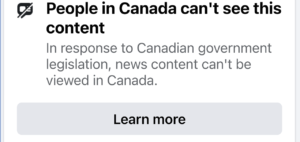
The impact of the ONA is far-reaching due to Google and Facebook’s different methods of reaching users.
Google indexes webpages, including news articles, so your keyword search (combined with location information) can return a topical article; it also has a Google News page that aggregates top stories and feeds many of the built-in news apps on Android devices. It’s not clear yet what results your search may yield after ONA’s full implementation – big stories may be available from sites outside Canada, like the BBC– but one way or another, the current system will change.
On Facebook, although users can follow a news outlet’s page directly, the primary way most users see news is when a story is shared by a friend. That adds a social component, as that friend’s endorsement is often a person’s only exposure to the story.
That’s tough to deal with. For any brand or issue campaign, getting your message out is certainly about quality, but it’s also about the quantity of people who see it (often referred to as your reach). Take the (somewhat ironic) example of the decline of newspapers in Canada. Just 10 per cent of Canadians said they follow stories about the topic “closely.”
On the other end of the spectrum, 31 per cent reported they “haven’t heard anything about” it. That leaves us with a very large middle group – about 60 per cent who’ve either “scan[ned] the headlines” or only “seen some media coverage.”
This group of casual news consumers is challenging to reach at the best of times, and now that their social tie to the news has been partially severed by Facebook, the challenge has only grown larger.
Block party: 5 Tips for Thriving in Canada’s New Earned Media Environment
Which online strategies don’t rely on a Google search result or Facebook referral to be successful? We’ve got some recommendations:
Create a hosted content ecosystem. Every brand campaign or public affairs push will need a news page hosted on its own website. Your Facebook and Instagram accounts can no longer act as passthroughs for directly sharing news updates or media mentions. Of course, continue to lean into your social media accounts, but if you need news links to keep your audiences aware of your issue or brand’s progress, direct those links to your self-hosted news page.
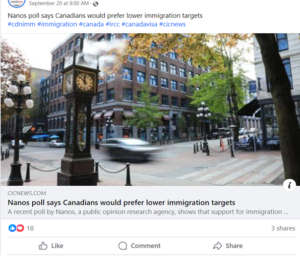
EXAMPLE: An immigration law firm has written a synopsis of a CTV news story on their firm’s own news website (CICNews.com). This form of news aggregation is an effective workaround—and one of the few remaining ways to amplify Canadian earned media on Facebook.
Avoid boosted News Link Facebook posts and Google Ads. It was never particularly good practice to put money behind a news headline that would link users directly to a news website, rather than your own website, but now that avenue is entirely closed. For example, when you land a big placement—a long-awaited Globe and Mail op-ed, say—it’s expected that Facebook and Google will be unable to accept your “boost” ads that place that story on your audience’s feeds or results pages.
Expand your owned content… While they are important for updating your audience, links to your own website—which in turn, summarize and re-link to actual news sites—aren’t very exciting and may ultimately be disfavoured by algorithms. Instead, redouble your efforts to make your own compelling content. Consider the entire spectrum of owned content. It could be TikTok videos, a guest Substack post, or doing your own survey and publishing the results on various channels.
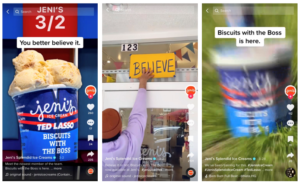
EXAMPLE: This TikTok launch of a new ice cream flavour in the US demonstrates how you can use resources more effectively by concentrating on core brand channels instead of earned media that will soon be unable to be found via Google, Facebook or Instagram.
and do more paid promotion. Highlight your best content and promote it through social advertising, pre-roll videos, influencer marketing—whatever it takes to bypass the link-blockers and tell the story you want to tell.
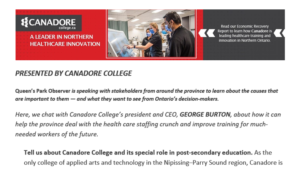
EXAMPLE: A sponsored Q&A embedded in a popular Ontario political daily email newsletter, the QP Observer.
Don’t forget about SEO. The ONA doesn’t just apply to today’s news – it also will apply to news articles that mention your brand or issue that were published in the past. Therefore, we can no longer rely on those stories appearing in Google search results to raise your profile and contribute to your online reputation.
For your own website, include many of those familiar search phrases in your web copy, and be sure your meta tags and Open Graph images and descriptions are properly configured. This will help with search indexing and make links to your website appear more attractive on social media sites.
In the past, when Canadian brands and campaigns were linking from their Facebook and Instagram to news sites directly, it wasn’t necessary to think about below-the-surface pieces of data. The burden has shifted – make sure your site’s news function is optimized for SEO and social.
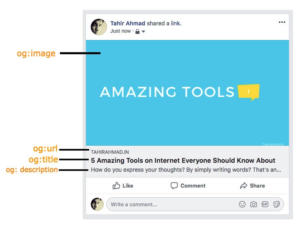
The above example is from Why You Should Know Facebook Open Graph. You can also check out this Open Graph tag guide from Ahrefs.com as well as Google’s SEO Starter Guide for developers.
Brace for impact
It’s important to be clear-eyed about the impact the ONA will have on the Canadian news and PR environment. In an already fractured and changing media landscape, Google and Facebook are two of the remaining online gathering spots, and the stats back it up: nearly all Canadians use Google and more than three-quarters have a Facebook account. Nine in 10 Canadians say they read news online.
By contrast, the proportion of the country that reads daily news in print (19 per cent) is about the same as the share of Canadians who think the government should have a task force and battle plan ready in case of alien invasion (17 per cent).
And while the truth might be out there, we’re wondering something else – do your Canadian PR practitioners have their battle plan ready for the Online News Act?